Modern motorists do not want to get the "handles" and almost all questions related to the problem of the Iron Horse are solved by contacting the service center. And although they carry certain expenses and lose time in anticipation of the approach of the queue - such people, these problems do not stop. For the same people to whom the road is every penny, we offer simple operations, and the replacement of the brake fluid is just such an easy operation, to perform with your own hands. But, making such a simple operation, car enthusiasts should remember that the safety of automatic management, directly depends on the braking system of your car. Naturally, since this is a responsible operation before performing this work with your own hands, carefully examine all the recommendations of professionals.
Content
- How often it is required to replace the brake fluid
- Brake fluid. What brake fluid is suitable for your car
- Brake fluid. When you can not change it with your own hands
- Brake fluid. Step-by-step instructions for replacing brake fluid
- Brake fluid. Check and pumping wheels when replacing brake fluid
- Tips motorists for the operation of the brake system
How often it is required to replace the brake fluid
Specifying the question of the frequency of replacement of the brake fluid, you can get several oncoming issues.
And the key is that this question implies several answers. The automotive market of consumables offers several different variants of the brake fluid.
And not because you can buy any liquid, depending on your desire.
The brake fluid must be purchased depending on your car, for example, for old cars, you can not purchase a brake fluid in the form of modern synthetics, because for these cars you can use only organic BRS brake fluid.
If you instead of the organic foul synthetics, then you will destroy all rubber and other metal compounds in the hydraulic circuit. Organic brake fluid change once a year and at the end of winter time, the BSK consists of butyl alcohol and castor oil. Car service professionals, when questioning about the frequency of brake fluid replacement, will tell you that the replacement is performed once every two years, but this refers to the brake fluid of the glycolic compositions DOT3-4 + and DOT 5.1. The reason for the replacement of the brake fluid of this class is the accumulation during time in the water brake system.
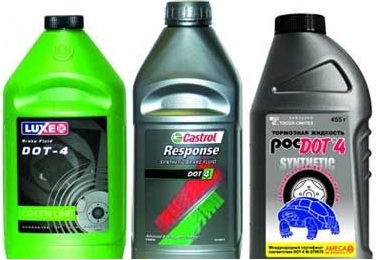
Water, getting into the brake system capable of increasing the temperature of freezing and reduce the degree of boiling point, so changing the brake fluid, you remove excess water.
If the brake fluid is poured on a silicone basis, such as DOT5, this liquid has very low hygroscopicity, and this allows you to extend the life of silicone brake fluid to 5 years.
But not in each case, the brake fluid is replaced due to the use of use, sometimes the brake fluid has to be changed due to the sharp deterioration of its characteristics.

Of course, if you have a special analyzer with which you can check the composition and parameters of your brake fluid is the best option.
But such a device has a high cost.
More simpler, for motorists, it is necessary to check the brake fluid tank and pay attention to the color of the liquid and if you saw that the fluid has become much darker - this is a signal for servicing your car.
Brake fluid. What brake fluid is suitable for your car
The correct selection of the brake fluid is the guarantor of your safety. If you want to know which brake fluid must be purchased for your car - find the instruction manual for your car and read the desired entry.
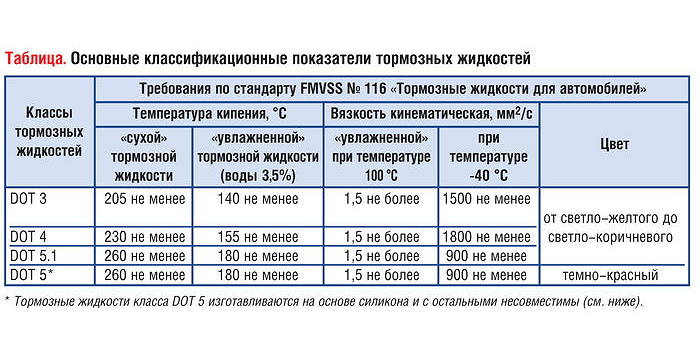
And if you want to know what exactly the brake fluid is in the brake hydraulic circuit of your machine, open the tank and look at the color of the brake fluid.
If you see a yellow or brown liquid, it means in your car there is a glycol-based brake fluid.
And if you see a red liquid, then the brake fluid contains a silicone content.
Remember! You can not mix different brake fluids in composition.
Remember! You can not pour two identical fluids from different manufacturers to the brake system.
Remember! You can not pour in the system brake fluids of different classes on DOT.
Only in emergency cases, you can break these commandments, but at the first maintenance station, you must replace a mixture of brake fluid into a homogeneous composition.
Brake fluid. When you can not change it with your own hands
There are several exceptions when self-replaced brake fluid.
You can not change my own brake fluid, in the car of which the brake circuit is equipped with an integral ABS.
In such cars, the hydraulic valve block is not combined with a hydraulic cylinder, so the brake fluid replacement is made in a certain order and only with the help of a branded tester.
In addition, you will not be able to independently replace the brake fluid on such cars, where innovative elements are built, in the form of an emergency braking assistant, where there are mechanisms that increase the stability of the machine and providing its course stability.
Brake fluid. Step-by-step instructions for replacing brake fluid
first step
Prepare consumables and tools, namely:
- we acquire the corresponding brake fluid;
- preparing end keys, 9,10,11;
- we prepare a transparent silicone tube 20-30 cm. Long, and 6 or 4 mm in diameter;
- prepare an empty plastic bottle, with a capacity of 1.5 or 2 liters;
- prepare pure rags;
- all work is carried out on a special overpass or in a garage with a observation pit;
- install the car so that you have free access to the bottom;
- post the wheels on the jacks and remove them, i.e. Get free access to brakes;
- install good lighting;
- examine your machine's maintenance manual, as various hydraulic circuits dictate a different sequence of replacement of the consumable material.
If the circuit of the hydraulics is installed in parallel, the work is carried out first on the right rear wheel, then the left rear and again the right front, then the left front wheel.
If the hydraulics is equipped with a diagonal layout - the work begins with the right rear wheel, then the left front wheel and the same left back, then the right front.
step two
Replacing fluid. Since the work is quite complicated, it should be done in a pair with another person.
Initially, it is necessary to unscrew the capacitance cover in which the brake fluid is located.
This expansion tank is under the hood, the float is mounted in the tank cover.
Work carefully, from the float can be a chemical to get into the arms, revealed cover. Put in an affordable place, go down under the bottom of the car and inspect the pressure regulator, which is between the rear wheels, lock it (you can lock it, placing a screwdriver between the case and drive).
Now we will specify everything that you need to do for each wheel alternately.
Firstly, clean the brake mechanism of the wheel from dirt, use the rags for this.

Remove the protective rubber cap, which is on the valve, it will appear in front of you, the silicone hose will appear on it, lower the hose into the plastic bottle with the liquid.
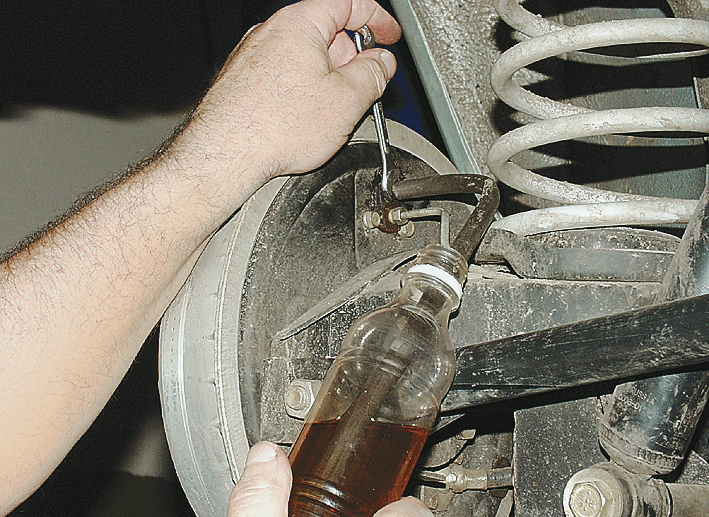
At this time, the second person sits in the car, tell him that he makes five short strong swing brake pedal and fixes the pedal in the lower position until the next instructions.
At this point, unscrew the valve to the floor of the turnover - the dirty brake fluid will be started out of the circuit, while weakening the jet, tighten the valve back.
After that, the assistant can let go of the pedal.
Different in the tank liquid so that you do not climb on top, it can make an assistant, the liquid should not fall below the minimum.
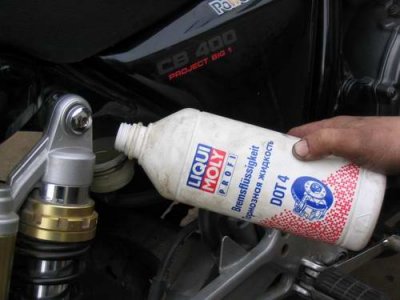
All described actions must be repeated as long as the hose does not flow a new brake fluid, it can be determined by the color of the fluid.
Brake fluid. Check and pumping wheels when replacing brake fluid
After you have done work on all wheels, you need to check the brake system.
Slowly press the brake pedal, we increase the impact on the pedal to the stop.
If air got into the brake system, the braking path will increase dramatically, the wheels will be unevenly braked and an emergency can be created.
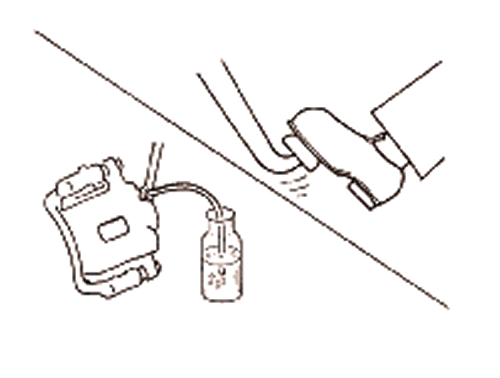
At the same time, the brake pedal will move unevenly, you will feel the jerk and failures.
You can check the car by driving on the deserted plot and carrying out braking at a speed of 40 km / h if the car is listed, it means the air is in the system.
To remove air, you need to make pumping.
And again the assistant sits behind the wheel, and you are under the car. Signal Assistant, Pushes 5 times again on the pedal and holds the pedal, unscrew the valve to the turnover, the pedal will touch the floor.
Tighten the valve again, and let the assistant let go of the pedal.
During the opening of the valve and press, the pedal follows the brake fluid with air bubbles.
This procedure is repeated before the air will disappear in the brake fluid. During pumping, there will be a brake fluid in the tank.
Tips motorists for the operation of the brake system

- follow the level of brake fluid in the expansion tank;
- check the level and color of the fluid (monthly);
- if the brake fluid has changed the shade of color, then moisture appeared to it and it is necessary to replace the brake fluid;
- if you are not sure of your work, it is better to take sure and contact the car service.
Related Materials
- Stove 2110, bad warm stove 2110, VAZ 2110 heating system, repairing the heating system VAZ 2110 with their own hands
- VAZ 2114 stove blows with cold air, stove 2114, bad warm stove VAZ 2114, device and repair of heating VAZ 2114 do-it-yourself, removing the stove VAZ 2114
- How to subdominize the car. How to put a jack. Types of jacks for cars.
- VAZ 2109 Fuse Block, VAZ 2109 Fuse Block Carburetor, VAZ 2109 Fuse Block Injector, Old VAZ 2109 Fuse Block, VAZ 2109 Fuse Block, VAZ Fuse Block 2109
- Car exhaust gas catalyst, faulty catalyst, pluses and cons of the catalyst, how to change the catalyst for the planeencitel
- Stove blowing cold air VAZ 2114, badly blowing the stove VAZ 2114, why badly blowing the stove VAZ 2114
- How to find out the owner of the car by the number of his car, check the car by the number of the traffic police machine, check the car by the state number of the car for free
- How to choose Used tires, Useful Tips
- Winter car road, pressure in passenger car tires in winter, good battery for the car in winter, whether to warm the car in winter
- In winter, the car is poorly started. How to make a car in winter, do you need to warm up the car in winter, useful tips
- Economy fuel consumption machines, the most economical car consumption
- Tires brands for passenger cars, labeling of car tire labeling, residual passenger car tire protector, how to pick a tire on a car brand, car tire tread pattern
- Working transmission operation, mechanical gearbox clutch work, driving with manual gearbox, useful tips
- Rear beam Peugeot 206 sedan, rear beam device Peugeot 206. Rear beam Peugeot 206 Malfunction, repair of the rear beam Peugeot 206
- Diesel fuel in winter, additive for diesel fuel in winter, how to choose the best diesel fuel
- Diesel winter does not start. How to start diesel in winter, heating diesel in winter.
- Japanese bridgestone tires, winter studded bridgestone tires, bridgestone tires brand
- Tire marking decoding for passenger cars, labeling wheels, how to choose the right tires on the disks
- Diesel engine in winter, launch of the diesel engine in winter, what oil to fill in a diesel engine in winter, useful tips
- LED backlight of the car, the backlight of the bottom of the car, the backlight of the legs in the car, the backlight in the door of the car, the backlight of the car is fine
- Recovered tires, bus tire, restored tire protector, can I use them
- Choose winter tires, which is a winter tires, which pressure in winter tires should be marked with winter tires, how to choose the right winter tires, the best winter tires 2019
- Steering rail rail, knock of steering rack, reasons for the knock and repair of the steering rack do it yourself
- Cameless car tires, a set for repair of tubeless tires, repair of the cannon-free tire do it yourself
- Russian tires, Russian tires Winter, Russian All-season tires, Voronezh AMTEL tires, Tires "Matador Omsk Tire", Kama-tires are world-class bus
- How to open a car without a key. Lost the key from the car what to do, the key from the car inside the car
- Silent tires, quiet winter tires, quiet studded bus, which tires to choose, overview tires
- Tires and safety, safety of the bus, why it is necessary to constantly monitor car tires
- Rules of safe driving of the car in the rain and slush, safe driving of the car for beginners
- Rust converter which is better for cars, rust converters to choose how to use rust transducer, professionals
- Polishing the body of the car do it yourself, how to choose a polishing paste, useful tips
- Engine durability, engine life, how to extend engine life
- Knock in the car. Knock when moving a car. What can knock in the car. How to determine the cause of the knock.
- ABS car, what is ABS car, ABS system malfunction, ABS diagnostics
- Overtaking a car when you can start overtaking a car, rules of traffic rules
- Fuel pump VAZ 2110, VAZ 2110 gas station scheme, VAZ 2110 fuel pump device, VAZ 2110 gas station repair,
- Automotive antennas for radio, automotive antenna device, car antenna do it yourself
- Front suspension Kalina, device front suspension Kalina, knock in front suspension Kalina, repair of front suspension Kalina
- Shock absorber Oil, best oil shock absorbers, pumping oil shock absorbers, how to properly pump oil shock absorber
- Clutch malfunctions, touches clutch, causes a clutch malfunction, how to eliminate







Comments